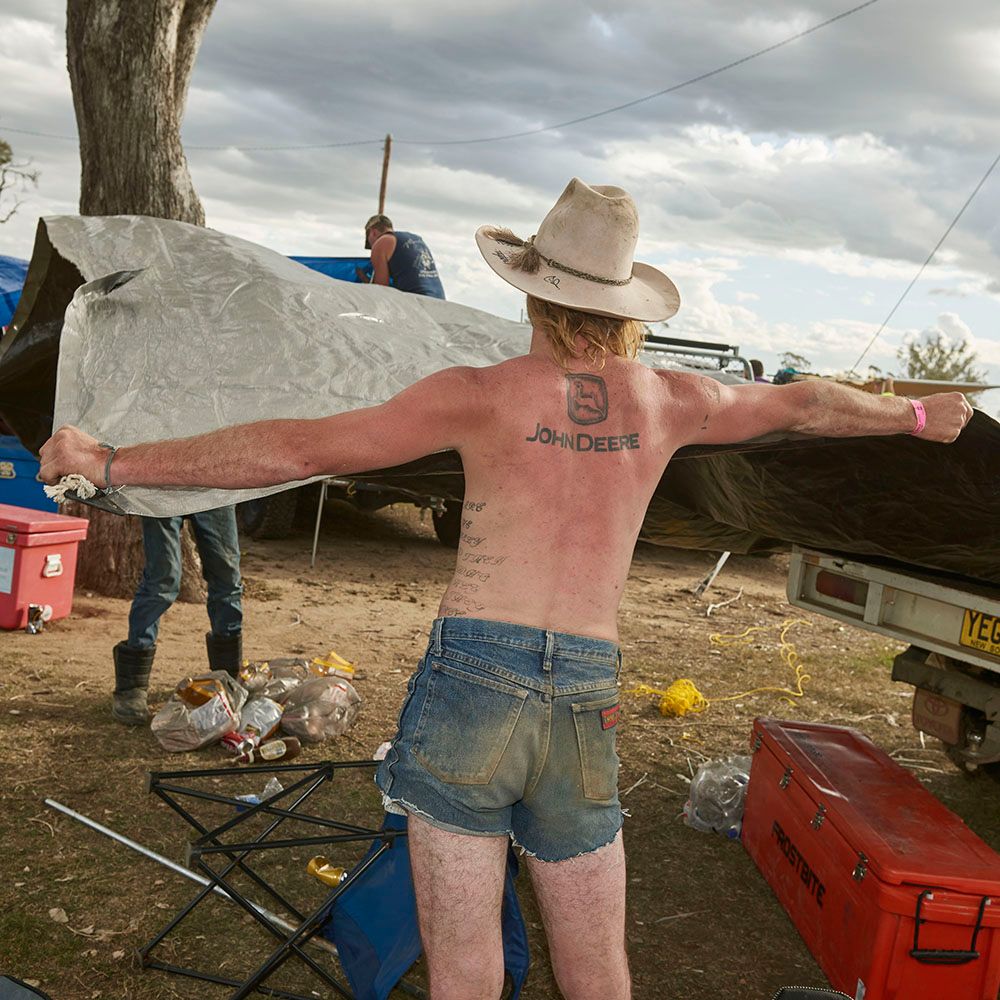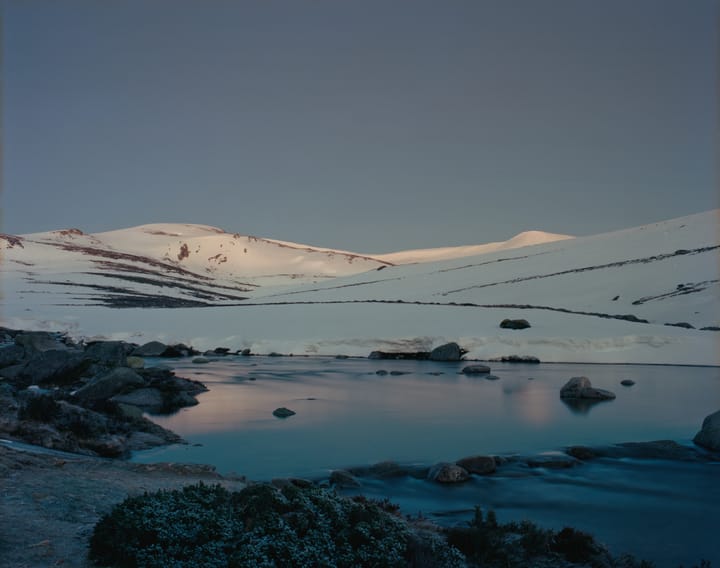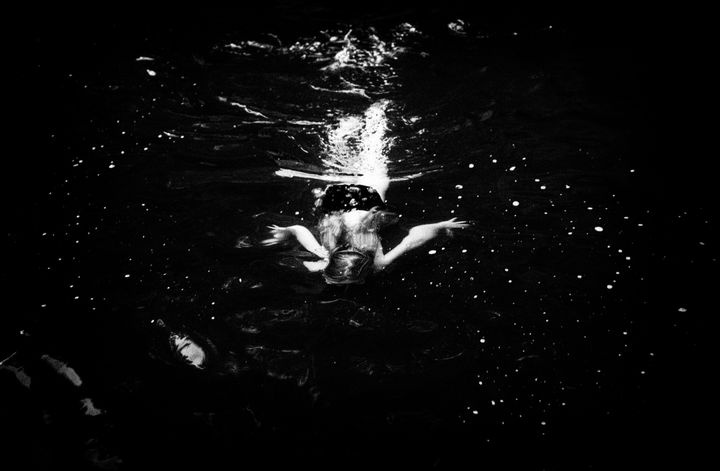Ingvar Kenne’s photographs have often represented a thorough exploration of identity and belonging. From his earliest works in his home country of Sweden, his highly acclaimed portrait monograph CITIZEN and a brief glimpse into the life of porn star Ron Jeremy in The Hedgehog and the Foxes, Kenne has focused extensively on both the everyday and the extreme periphery of social circles.
But across his practice, Kenne has been unwavering in his approach to his subject matter. Namely: there is no approach. Throughout his several decades making portraits including those of such Australian icons as Reg Mombassa and Ben Mendelsohn, Kenne maintains the omission of any narrative connecting his chosen sitters “other than that they met me and my camera, applying the same parameters and taxonomic approach,” he says. Whether “a prime minister, a prostitute, famous actors, my wife, a priest and a nun, tribal dancers or a now dead friend”, Kenne’s choice of subject matter has been purely democratic across “one long random thread of encounters” in his life.
So it was no surprise to hear that for his latest work, The Ball, Kenne’s lengthy foray into the world of bachelor and spinster’s balls in the Australian desert came about with little more thought than skimming a wikipedia page and driving off into the desert in the middle of the night.
B&S balls were originally founded as social events aimed at prompting potential relationships for farmers by overcoming the lengthy distances between localities in Australia’s interior. But over the last few decades, what were once white-glove-wearing formalities have devolved into seemingly pure chaos.
At the suggestion of fellow Sydney-sider Simon Harsent, Kenne documented ten B&S balls across the span of four years with the resulting work becoming a book late last year under the banner of Scandinavian publishing house, Journal Photobooks. Developing the edit with Dutch photobook expert Corinne Noordenbos and receiving instant praise from Magnum photographer Mark Power, The Ball has joined a long list of highly acclaimed works from Kenne and has already garnered much attention from his peers across the globe.
At his studio in the inner-Sydney suburb of Glebe, Kenne recounted the fear, long distances and pure anarchy of his first few B&S Balls and ran us through the feeling of receiving a very polite rejection letter from Tim Winton.
What drew you to B&S balls as a subject for photography?
A lot of my project just sort of happen. I don’t research anything really. You know, portraiture is really what I’m known for but a long while ago a karaoke project happened while I was on a job in China, out one evening when I heard some music upstairs. I just ended up going up there with a camera and spent the night getting quite drunk and taking photos. I really liked what came out of it so that’s how that project came about and continued.
From there I got a job following Ron Jeremy the porn star. Starting out on that, we didn’t really have a plan for how we were going to do it but I suggested this similar method from the karaoke project which is to look for chaos within the square, just to be sort of in the moment. And there were a lot of night shots involved too so I was after a kind of similar flavour.
So then after a few more similar projects somewhere along the line, Simon [Harsent] suggested that I just continue on this sort of theme of just drunk Australia and mentioned B&S balls. I have no interest in drunken behaviour per se. I think that there is something with those sort of setups with people en masse where people let go and human emotions are sort of condensed and more pointed. It’s a very giving situation to be in as a photographer to kind of access that energy. It’s easier than walking the streets and trying to find those moments. You see everything on the human spectrum and with alcohol or drugs involved they are still real moments, but the intensity and frequency are elevated and certainly helped along by those substances.


When first viewing the work this seemed to me to be a lot about identity but I was also tempted to compare these B&S balls to say frat culture in America or mid-summer parties in Scandinavia. How did you initially approach the making of the work and attending these B&S balls?
Again, because I don’t really research there’s actually quite a lot of fear involved in the initial process. Like, to go into a karaoke bar without a camera by myself is probably right up there on list of situations that I don’t really want to find myself in – being handed a microphone, you know! I’ve had a lot of fear through everything that I’ve done including shooting a lot of portraits but I find that with a camera it has given me the perfect reason to dare to do what I typically wouldn’t. For me, the photos are the reason that I find myself in the karaoke bar or at a B&S ball. But it also makes you stand out within these spaces: I’m certainly not a young person at a B&S ball nor an Asian singer in a karaoke bar in China so the camera also becomes a protector; a safe place. I always make sure that it’s obvious that I’m a photographer and that that’s what I’m there to do.
So, for the B&S project, I read a wikipedia page and that was about it – I just went to the first one. From then on I shot ten balls but I didn’t really look at anything from the first eight. I did a quick selection and sent them to people I had met so that they could use them for social media and that sort of thing which meant I had to go through them very quickly on the day or the next day. But I really let it go on for about two years without looking at the pictures because I didn’t want the work I had shot to inform what I should chase, I just wanted the situation to inform me rather than me to inform the situation and that seems to be my approach with all my work.
Absolutely. So, tell me about the first B&S ball you attended. You just drove off into the desert from Sydney one day?
The first ball I attended was in Goondiwindi so that took 10 hours drive to get there. I left Sydney at like 4 in the morning so I got there in the middle of the day which is when the ball started, I shot until 2 in the morning, slept for a few hours and then drove home.
It was crucial to be on my own. I couldn’t work like that having other people with me.
I was so scared about the whole idea of walking in to one of these things. You know, it’s like a big show ground or something where they all camp and they have this fenced off area where the ball takes place later when the sun goes down. When I went to the first one I had a camouflage land rover which is a stand-out object straight off the bat! [laughs] So I was driving around trying to find a place to park and just got really hammered with heckle! It was a big thing to take those first steps and to just walk into the mass of about 1000 plus people.
I really wanted to make that first ball count and I was really on the lookout for photograph that resonated – whatever that was – and I felt like I was interrupted by the kids always asking me to take their picture. And then this guy came up to me sometime in the middle of the night and just said ‘mate, lighten up. You’ve been walking around this whole time with a cloud over you. Have fun.’ Then, it just sort of clicked for me that I needed to reverse the whole thing you know, offer my self up – that’s the way that you can make your first contact and then they know who you are. It became my approach for each ball from then on: as soon as I landed I would walk around the campground, approach everyone and ask if they wanted their photo taken. A couple of hours into that process everyone knew who I was and we had a relationship of sort.
So, are these events formally organised or they just sort of come about through social media?
They are all organised by a committee and are basically a big fundraiser for the town – all the proceeds go to the local RSL club or similar. And they happen all year round; it could be a summer event or a winter event. Often towns just decide on a regular weekend when they have these events and there’s facebook pages with calendars. But I also had The Pool Collective get me permission to be there and I often paid the entrance ticket and every time they just invited me to come along. I really needed that awareness that I was there as a photographer and so in return I would send them a few hundred photos that they could use on social media just to say thanks for having me. It was important that they needed to know who I was before turning up.
Brilliant to see that Magnum photographer Mark Power put The Ball among his top photobooks of 2018 and even compared its anarchic flavour to that of Trent Parke’s Christmas Tree Bucket. What was your reaction to that?
That was a very nice surprise! So, the book was released during Paris Photo so I was over there and we launched it among hundreds of other titles that week. We just had the first advanced copies of The Ball then but we got it to Photobook Store UK and I assume that Mark just knows them pretty well and probably looks at stuff there all the time.
It’s been really exciting the coverage that the book has already. I’ve done quite a few books and I’m probably equally proud of all of them but having said that I do have quite a few copies left of most of them – you know, they’re not bestsellers so it is always nice to have more attention from the outset!
So, at this time when there’s so much dialogue surrounding masculinity and these sorts of themes in the media, it’s tempting when first viewing this work to at least think about that. Like ‘crazy young men out in the bush going wild’. What sort of reception has the work seen from the media in this sense thus far? What have people’s initial reactions been?
I’ve definitely had a few questions geared towards that sort of male dominance thing. I don’t have any numbers but it definitely seems like there are just as many women at the B&S balls as there are men. But that’s the thing: I don’t necessarily want to talk all that much about B&S culture in general because I find it a bit confronting sometimes and still a layman. I really like all the people that I met. I never had one bad experience. They all seem to be great, hard working people, many of whom live 2 or 3 hours outside any sort of town – one guy drove a day and a half to come to a ball I was at – so they are very isolated and these events mean they can meet someone or meet their mates or whoever – maybe even strike up a relationship. There’s no other way of meeting people really if you live out on a farm as big as an Irish county. So, in a way it seems very obvious as to why these balls exist however they have definitely taken a turn to something different to what they once were. But times change, you know.
So, it’s really just that this is a spectacle that I’m interested in photographically. I never go in to one of these B&S balls with a narrative in mind – it kind of transforms into something once you start to sequence th e images. For me, it’s always about the photographs themselves and each photograph has to stand on its own. Then those images – which amounted to about 150-200 in the initial selection – you attempt to tell a larger story out of that. But to me the book is a pretty neutral in its storytelling (I am Swedish after all) and very tame in comparison to some things that never made the book.
Haha! So, speaking of sort of conscious decisions when making pictures: you’re photographs are often square and often employ (for this work) very sort of unflattering, descriptive lighting. What was your intent with the technical choices that you made for the work? Was this aesthetic a product of a visual language you have relied on before or was it more tailored to this series?
Yeah, it’s kind of a thing that I’ve had in place for the karaoke project and even Ron Jeremy. Karaoke was shot on film but Hedgehog and the Foxes was a job so it was shot digitally. [shooting digital] is just the nature of that kind of work; because of the times you are in. That generation, the expectations and this culture of constant sharing mean that this would have been almost impossible to shoot on film. You know, to walk around with a 35mm Leica and to shoot technically identical images but on film would cause a lot of suspicion I think because people want to know what you are doing. This generation sees images all the time. You know, to walk down to the corner and do street photography with a Leica is a totally different thing but here I was shooting non-stop and if you don’t have anything to show or to share after the fact wouldn’t go down that well. It’s just nature of the beast.
But yeah, that method and that way of looking at things was probably established when I was shooting the Karaoke project and since then I’ve had a very similar [technical] approach to most of my projects, including this one. There’s no zooming in, if you want to capture the action you have to jog over there and be in it. And flash.
How did your Swedish heritage but also your sort of “city-dweller” identity inform this work? Were the country kids at these B&S balls at all conscious of you as sort of an “outsider” and do you think this influenced the work?
I didn’t even attempt to fit in really because it would have been impossible. I’m decades older than most of the kids there, I wear a bright-coloured vest and carry a big, fat camera so you know, I didn’t play it up but I was aware that I was going to stand out. That emphasised my fear to some extent but at the same time they are also a really welcoming bunch of people. Also, because of the nature of the party nobody really has their iPhones out taking selfies like you might expect. So, a lot of them approached me to say ‘we don’t really have these things documented; it’s so great that you’re here’ and that they actually have a memory of this now – of their mates and as a record of the times they have had.
I think being Swedish though… you know, I identify very much as an Australian, I’ve been here 22 years and I’m a citizen. But I had no knowledge of these B&S balls until Simon told me about them so I obviously have some kind of disconnect to Australian culture. Possibly that helps me, it might be a good thing. One thing I know from my travels in other parts of the world is that it can often help to be a stranger when photographing. The hardest place for me to photograph is Sweden because people are more suspicious of why I am asking to say take a portrait. Where as, if you are a stranger people seem to think ‘oh you’re just curious’.
I understand that the book will feature a letter from Tim Winton. How did he come to be aware of the work and what was his take?
So, I sent a box of prints unsolicited to his PO box in Fremantle. This was after I had shot the first eight B&S balls. My letter to him is in the book and so is his response. He basically concluded in his response that ‘this is not anything for me to write about; good luck’ so it is a rejection letter to my request of sort. But it is a very generous rejection letter in response to unsolicited material because he really spent time on thinking it through, and crafted some crucial thoughts that I asked to include in full. We have actually since ended up collaborating on some other work – he used some pictures of my sons for a talk he was giving about toxic masculinity.
Thinking about what these balls once were to how they look now, I wondered how much this work is about the shedding of tradition for these kids. As much as a right of passage as Tim Winton mentions. Did you get a sense of that when making the photographs?
Well for me, I didn’t really set out to do this work with much knowledge. It’s really only when I sort of finished it; when I had shot the ten balls and attempting to edit and sequence the work. It’s then that those questions arise of what those images represent to myself? What is it that I’m looking at? And what do I feel about what I’m looking at? This is related to the letters in the book because in Sweden we have midsummer parties, in America we have spring break on the Gold Coast we have schoolies. These events go on all over the western anglo world where youth have a need to go absolutely batshit crazy, often at the cusp of transitioning into adulthood. Different exposition, same trip?
My musings I guess are that in the past, cultures seemed a lot stronger and there was a lot of passing down of knowledge and in particular looking at indigenous cultures but here as well in The Ball this kind of initiation into something and knowledge that has been around for a very long time and is structured because they are close-knit and bonded communities. I think we all need to grow but these sort of traditions don’t necessarily exist anymore because we are not a close-knit society anymore. People fend for themselves. So this process of growing up is sort of left to the youth to find their own way through alcohol and parties.
As Tim says, these events [B&S balls, midsummer etc] seemed franchised and the balls that I attended were like groundhog day, it all seemed like one ball because they were so structured, they were so similar going from one to the next. So repetitive.
Sort of wrapping up here: what did the editing process look like? Did you turn to friends/collaborators for feedback on the work?
A few years ago I attended a bookmaking workshop with Corinne Noordenbos. She’s been instrumental in the careers of a number of Dutch photographers. The Ball was the work that I brought to that workshop and that’s when it all changed for me. That process with her and all the other photographers at the workshop was amazing. A lot of my other books I’ve done with designers and we’ve worked out what it is going to look like over time but this workshop was completely eye-opening; everything was just magic. Since then, I’ve stayed in touch with Corinne, we’ve been Skyping for most of early 2018 and worked on sequence together.
I don’t necessarily listen to everything that others say but it’s always good to hear what they get out of it. Editing is the time I invite others to mould it with. In the process of making a book, editing is the hardest part of the journey for me.








